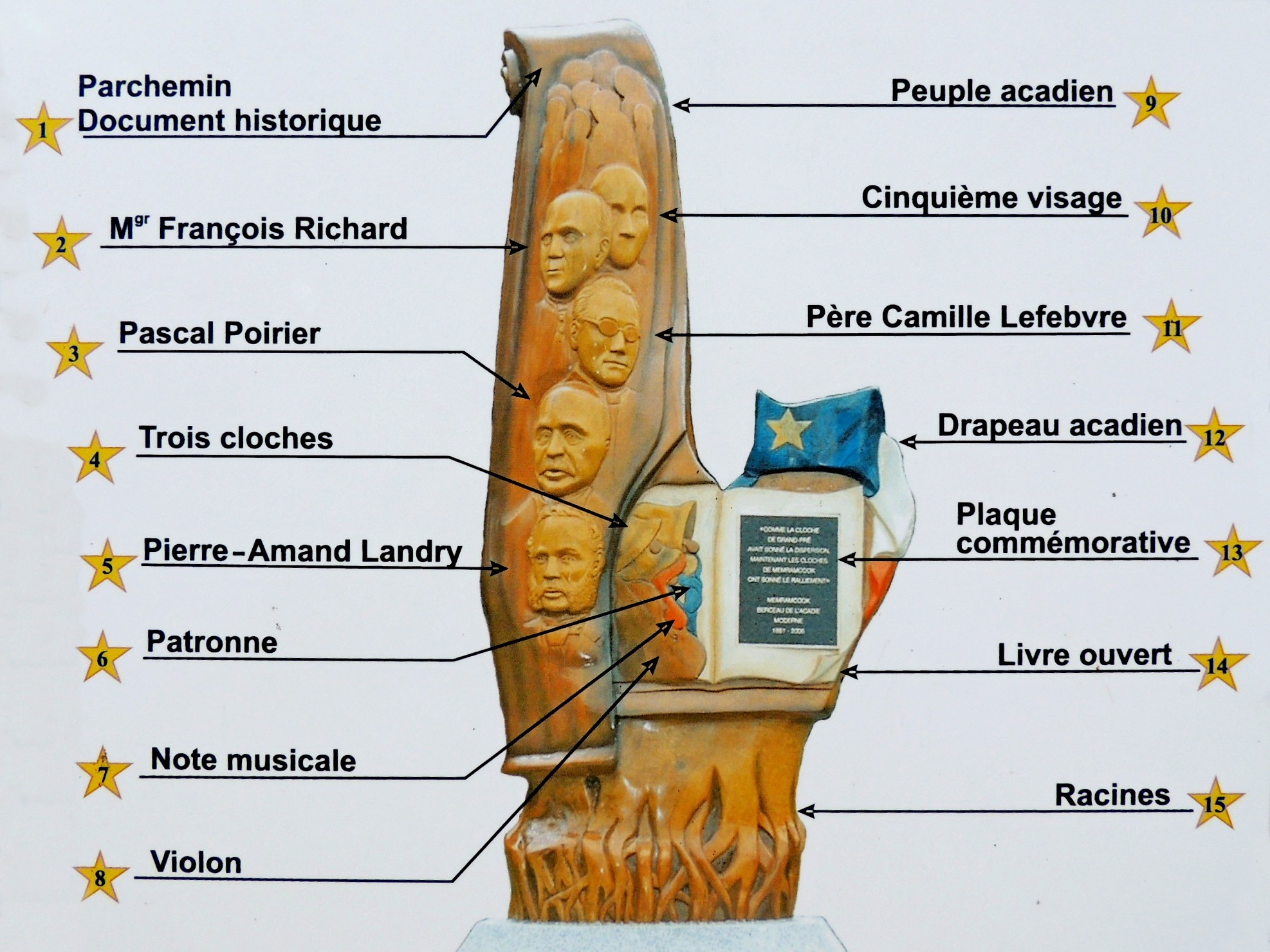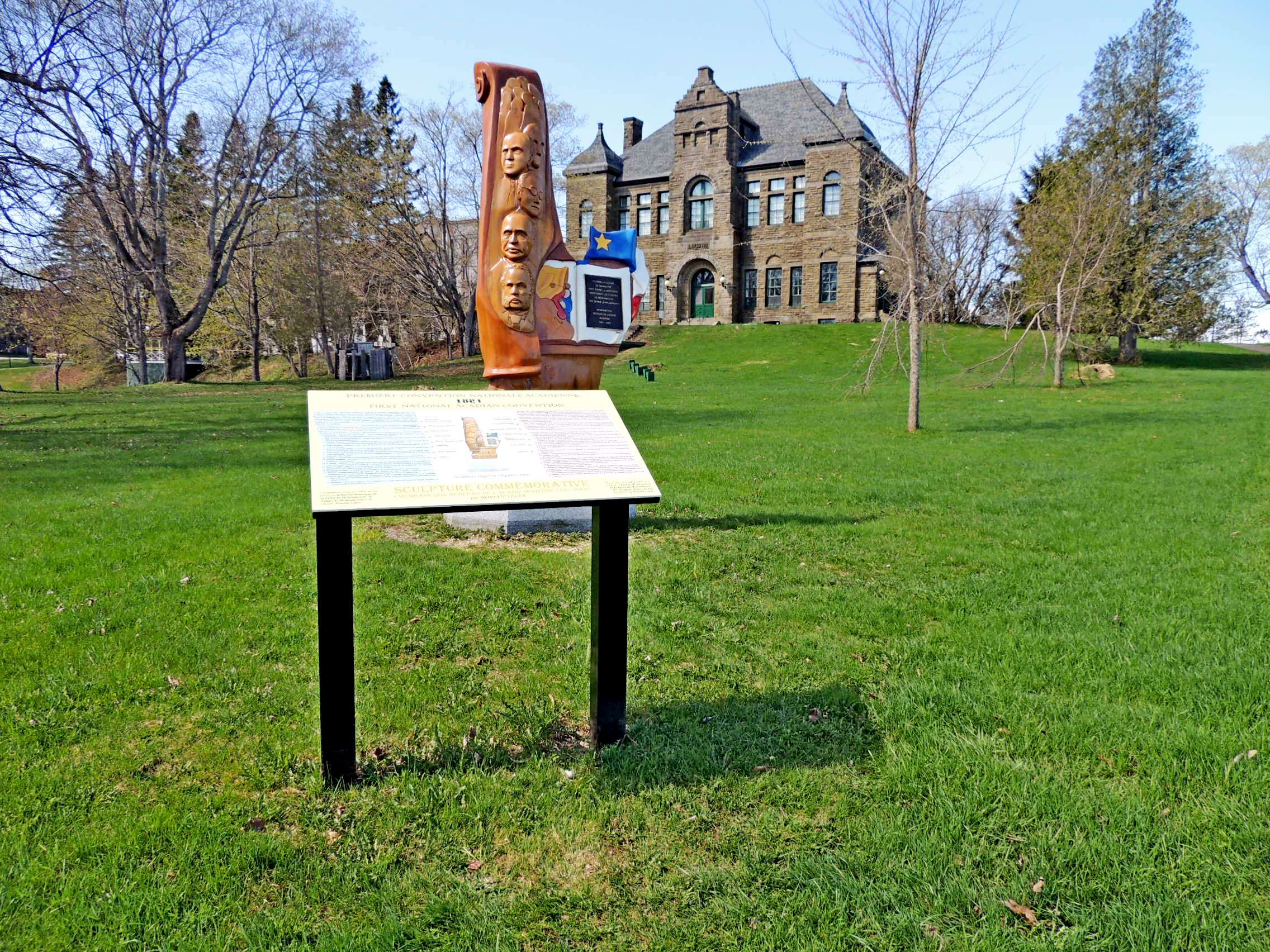|
 First National Acadian Convention - Memramcook, NB Posted by:  T0SHEA T0SHEA
N 45° 58.776 W 064° 33.965
20T E 378690 N 5092973
Near the Monument Lefebvre building, on what was once the campus of Saint Joseph’s College in Memramcook, is a beautiful sculpture, accompanied by this informational panel.
Waymark Code: WMRVVX
Location: New Brunswick, Canada
Date Posted: 08/09/2016
Views: 4

The sculpture was done in 2006 to commemorate the 125th Anniversary of the First National Acadian Convention which was organized and held here at Saint Joseph’s College in 1881. Since that time a total of ten national Acadian conventions have been held between 1881 and 1937. It was at the first two conventions, in Memramcook (1881) and then in Miscouche (1884), that the Acadians first asserted themselves as a people with a distinct national identity who were to be distinguished from the French Canadians. It was at the second convention in Miscouche that the Acadian Flag (to the right) and their anthem, Ave Maris Stella, were adopted.
Containing 15 separate elements, the sculpture was the work of Acadian artist Monette Léger. The image below points out the 15 elements of the sculpture, while the text below, from the accompanying panel, contains further explanation.

In July 1881, the Acadian elite organized the first national convention of the Acadian people. Presided by Pierre-Amand Landry, a native son of Memramcook, the convention rallied more than 5000 people at Saint-Joseph College, the educational institution founded by father Camille Lefebvre in 1864. The main topics addressed by the committees were: education, agriculture, colonization, emigration and the press. Under the initiative of Mgr Marcel-Francois Richard who insisted that the Acadian people deserved to assert their existence in a solemn manner. August 15 was chosen as the Acadian national holiday and Our Lady of the Assumption as the protector of the Acadian people.
With 2006 marking the 125th anniversary of this great event, Memramcook celebrated the occasion by organizing various commemorative festivities. These were highlighted by the unveiling of a sculpture by Monette Leger, carved out of a hundred year old tree, as a reminder of the first national convention.
The themes of the sculpture, outlined in the central diagram, are detailed below.
1 Scroll / Historical document: Represents the history of the Acadian pioneers who forged our identity by establishing the symbols of our culture.
2 Mgr Marcel-Francois Richard: Originator of the Acadian flag, recognized by many as one of the greatest Acadian nationalists.
3 Pascal Poirier: The first Acadian senator and one of the principal organizers of the first Acadian National Convention held in Memramcook in 1881.
4 The Three Bells: Representing those that rallied the Acadian people 125 years ago.
5 Pierre-Amand Landry: Was at the forefront in the organisation and the unfolding of the first three Acadian National Conventions.
6 Patron: The silhouette of Our Lady of the Assumption, chosen as protector of the Acadian people in 1881.
7 Musical Note: Marks the national anthem "Ave Maris Stella" as well as the national holiday of August 15.
8 Fiddle: A traditional instrument used to unite Acadians.
9 Acadian People: Represents our farmers, our fishermen, our business men and women ... all of us Acadians.
10 5th Figure: Represents the many other individuals who played an important role in the first Acadian convention, like Onesiphore Turgeon, Ferdinand Robidoux, Philias Bourgeois, etc.
11 Father Camille Lefebvre: Founder of the College Saint-Joseph in Memramcook, greatly responsible for the preparation of a well-educated Acadian elite.
12 Acadian Flag: A symbol ofAcadian identity.
13 Bronze Commemorative Plaque: "Just as the bell at Grand-Pre had announced the dispersion, the bells at Memramcook have now tolled the rally". (From Father Lefebvre's address)
14 Open Book: Represents education and the press, key elements of the first convention; also representative of the bible and of a page of history with many more pages to come.
15 Roots: represent the origins, the revival and the gathering of a people rich in culture and history.

Acadian National Conventions
Can you identify which Canadian flag has a yellow star, and three broad stripes in blue, white and red? It is the Acadian flag. Although it has ancient roots, it does not date from the time of Evangeline. It is one of several Acadian symbols adopted at the second Acadian National Convention at Miscouche in 1884.
Between the years 1881 and 1937, there were ten Acadian National Conventions in all. Together, they laid a basis for the survival of a people who had almost ceased to exist – the Acadian people. Since the early days of the French Regime, they had lived in Nova Scotia, New Brunswick and Prince Edward Island. In 1760, however, a new British government expelled them from their homes and transported many to Louisiana. Some Acadians hid and relocated in remote areas of the maritimes. Others returned from exile. They lived for the next century in poor, isolated communities.
During the mid-nineteenth century, authors Edmé Rameau de Saint-Père, a Parisian, and Henry Wadsworth Longfellow, an American, drew world attention to the Acadian plight. Their works generated a legitimacy for the Acadian people – one which resulted in the founding of a newspaper, Le Moniteur acadien, in 1867. In 1881, politician and judge Pierre-Amand Landry and the Roman Catholic Church encouraged Acadians from all parts of the maritimes to gather to discuss their future in the new Confederation. Their meeting at Memramcook was so successful that it established a society to co-ordinate future conventions.
Together, ten national conventions held during the next fifty years restored the vital dynamic of Acadian life. The Acadian people gave them strong support. By the time the society held its second convention in Miscouche in 1884, over 108,000 Acadians had joined. This convention adopted symbols to proudly serve as identifiers of Acadian culture – a flag, a patron saint, an anthem, an insignia and a slogan. With faith and confidence in their roots, Acadians went on to plan for their future survival. Subsequent conventions set up the means to implement communication, to ensure French-language education, and to ensure the development of professional and creative capability as a force of renewal. They created a program to undercut American emigration, then examined agricultural, commercial and industrial potential to establish a base for future prosperity.
Today's Acadians are confident of their identity. Their unique culture, characterized by the Roman Catholic faith, the French language, and a distinctive historical and community experience, makes a rich contribution to Canadian life. The ten Acadian National Conventions (1881-1937) were an important catalyst that fostered cultural rebirth. The joy of being Acadian is celebrated every year on August 15, the festival of Notre Dame de l'Assomption, Acadian National Day.
From Parks Canada
Group that erected the marker: La Société historique de la Vallée de Memramcook

Address of where the marker is located. Approximate if necessary:
488 Central Street
Memramcook, NB Canada
E4K 3R3

URL of a web site with more information about the history mentioned on the sign: Not listed

|
Visit Instructions:
Take a picture of the marker, preferably including yourself or your GPSr in the photo. A very detailed description of your visit may be substituted for a photo. In any case please provide a description of your visit. A description of only "Visited" or "Saw it while on vacation" by anyone other than the person creating the waymark may be deleted by the waymark owner or the category officers.
Recent Visits/Logs:
| There are no logs for this waymark yet. |
|
|
|
|